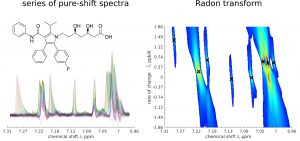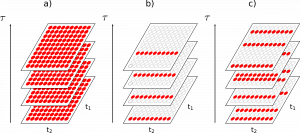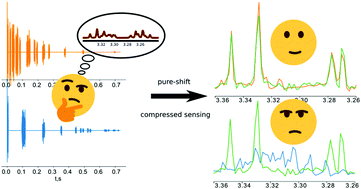New Article in Physical Chemistry Chemical Physics
08 August 2019Quick temperature-swept pure-shift NMR: case of solvent effects in atorvastatin

Małgorzata Rytel, Paweł Kasprzak, Piotr Setny and Krzysztof Kazimierczuk
Pure-shift NMR experiments provide highly resolved spectra, that could be perfect for precise monitoring of chemical shift variations under different conditions, such as temperature or concentration. However, their sensitivity is quite low and signal sampling is time-consuming, leading to long experimental times and making such serial acquisition problematic. In this paper we present a new method of NMR spectroscopy improving the speed and sensitivity of serial pseudo-two-dimensional pure-shift experiments. The example of variable-temperature study of atorvastatin reveals the potential of the method in verifying the theoretical predictions of solvent-dependent spectral effects.
New Article in Chemical Communications
Accelerated acquisition in pure-shift spectra based on prior knowledge from 1H NMR
Alexandra Shchukina, Magdalena Kaźmierczak, Paweł Kasprzak, Matthew Davy, Geoffrey R. Akien, Craig P. Butts and Krzysztof Kazimierczuk
Pure-shift NMR enhances spectral resolution, but the optimal resolution can only be obtained at the cost of acquisition time. We propose to accelerate pure-shift acquisition using optimised ‘burst’ non-uniform sampling schemes [I. E. Ndukwe, A. Shchukina, K. Kazimierczuk and C. P. Butts, Chem. Commun., 2016, 52, 12769] and then reconstruct the undersampled signal mathematically. Here, we focus on the reliability of this reconstruction depending on the sampling scheme and present a workflow for the sampling optimization. It is ready to be implemented in routine measurements and yields a great improvement in reconstruction of challenging cases.
New Article in ChemistryOpen
12 March 2019Monitoring Hydrogenation Reactions using Benchtop 2D NMR with Extraordinary Sensitivity and Spectral Resolution
Dariusz Gołowicz, Krzysztof Kazimierczuk, Mateusz Urbańczyk, Tomasz Ratajczyk

Low‐field benchtop nuclear magnetic resonance (BT‐NMR) spectrometers with Halbach magnets are being increasingly used in science and industry as cost‐efficient tools for the monitoring of chemical reactions, including hydrogenation. However, their use of low‐field magnets limits both resolution and sensitivity. In this paper, we show that it is possible to alleviate these two problems through the combination of parahydrogen‐induced polarization (PHIP) and fast correlation spectroscopy with time‐resolved non‐uniform sampling (TR‐NUS). PHIP can enhance NMR signals so that substrates are easily detectable on BT‐NMR spectrometers. The interleaved acquisition of one‐ and two‐dimensional spectra with TR‐NUS provides unique insight into the consecutive moments of hydrogenation reactions, with a spectral resolution unachievable in a standard approach. We illustrate the potential of the technique with two examples: the hydrogenation of ethylphenyl propiolate and the hydrogenation of a mixture of two substrates – ethylphenyl propiolate and ethyl 2‐butynoate.
New Article in JMR
09 February 2019SCoT: Swept Coherence Transfer for quantitative heteronuclear 2D NMR
Dariusz Gołowicz, Mateusz Urbańczyk, Alexandra Shchukina, Krzysztof Kazimierczuk

Nuclear magnetic resonance (NMR) spectroscopy is frequently applied in quantitative chemical analysis (qNMR). It is easy to measure one-dimensional (1D) NMR spectra in a quantitative regime (with appropriately long relaxation delays and acquisition times); however, their applicability is limited in the case of complex samples with severe peak overlap. Two-dimensional (2D) NMR solves the overlap problem, but at the cost of biasing peak intensities and hence quantitativeness. This is partly due to the uneven coherence transfer between excited/detected 1H nuclei and the heteronuclei coupled to them (typically 13C). In the traditional approach, the transfer occurs via the evolution of a spin system state under the J-coupling Hamiltonian during a delay of a fixed length. The delay length is set on the basis of the predicted average coupling constant in the sample. This leads to disturbances for pairs of nuclei with coupling constants deviating from this average. Here, we present a novel approach based on non-standard processing of the data acquired in experiments, where the coherence transfer delay is co-incremented with non-uniformly sampled evolution time. This method allows us to obtain the optimal transfer for all resonances, which improves quantitativeness. We demonstrate the concept for the coherence transfer and multiplicity-edit delays in a heteronuclear single-quantum correlation experiment (HSQC).
New Article in Concepts Magn Reson Part A.
Alternative data processing techniques for serial NMR experiments
Alexandra Shchukina, Mateusz Urbańczyk, Paweł Kasprzak, Krzysztof Kazimierczuk

NMR measurements are often performed in a serial manner, that is, the acquisition of an FID signal is repeated under various conditions, either controlled (as temperature or pH changes) or uncontrolled (as reaction progress). The traditional approach to process “serial” data is to perform the Fourier transform of each FID in a series. However, it suffers from several problems, in particular, from the need to sample full Nyquist grid and reach a sufficient signal‐to‐noise ratio in each separate spectrum. The problems become particularly cumbersome in the case of multidimensional signals, where sampling is costly and sensitivity is an issue. Over the years, several methods of alternative, “joint” processing of FID series have been proposed. In this paper, we discuss the principles of some of them: Accordion Spectroscopy, Multidimensional Decomposition, Radon transform, a combination of Compressed Sensing and the Laplace transform. According to our knowledge, this is the first review on serial NMR data processing approaches. The reader is provided with MATLAB scripts allowing to perform simulations and processing using these algorithms.


